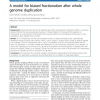Free Online Productivity Tools
i2Speak
i2Symbol
i2OCR
iTex2Img
iWeb2Print
iWeb2Shot
i2Type
iPdf2Split
iPdf2Merge
i2Bopomofo
i2Arabic
i2Style
i2Image
i2PDF
iLatex2Rtf
Sci2ools
RECOMB
2012
Springer
2012
Springer
A Model for Biased Fractionation after Whole Genome Duplication
Background: Paralog reduction, the loss of duplicate genes after whole genome duplication (WGD) is a pervasive process. Whether this loss proceeds gene by gene or through deletion of multi-gene DNA segments is controversial, as is the question of fractionation bias, namely whether one homeologous chromosome is more vulnerable to gene deletion than the other. Results: As a null hypothesis, we first assume deletion events, on either homeolog, excise a geometrically distributed number of genes with unknown mean μ, and a number r of these events overlap to produce deleted runs of length l. There is a fractionation bias 0 ≤ j ≤ 1 for deletions to fall on one homeolog rather than the other. The parameter r is a random variable with distribution π(·). We simulate the distribution of run lengths l, as well as the underlying π(·), as a function of μ, j and θ, the proportion of remaining genes in duplicate form. We show how sampling l allows us to estimate μ and j. The main part of ...
| Added | 29 Sep 2012 |
| Updated | 29 Sep 2012 |
| Type | Journal |
| Year | 2012 |
| Where | RECOMB |
| Authors | David Sankoff, Chunfang Zheng, Baoyong Wang |
Comments (0)

